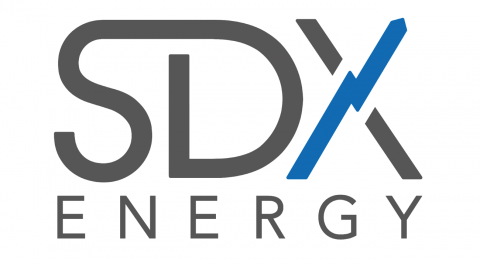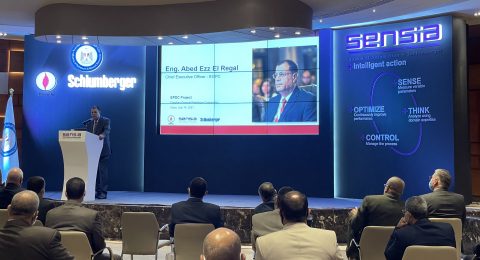Advances in directional drilling technology have enabled more complex trajectories to be drilled and brought hard-to-reach reservoirs within range. These drilling technology advances have driven the parallel development of near bit sensor technology that serves both the driller and the petrophysicist.
This “formation evaluation-while-geosteering” capability capitalizes on advances across the spectrum of at-bit sensor technology, from the most fundamental inclination-only sensors for rotary steerable drilling, to an azimuthal focused resistivity sensor with a “resistivity-at-bit” measurement for rotary steerable and motor applications.
Sensor Technology for Rotary Steerable Drilling
To successfully drill complex wellbore geometries using rotary steerable technology, real-time measurement of drilling data is critical. As a result, sensors for Rotary Steerable System (RSS) applications have moved closer to the bit, with the latest sensors measuring hole angle, formation gamma ray and even rotational efficiency, virtually “at-the-bit” to provide timely data for accurate geosteering.
At-Bit Inclination (ABI) – In directional applications, the most critical real-time drilling data is hole inclination, which for years has been obtained using MWD survey tools located 50 to 75 feet or more behind the bit. This sensor positioning causes “blind drilling” in the footage between the sensor location and the bit.
To mitigate this risk, an ABI sensor is incorporated into a point-the-bit rotary steerable drilling system just three feet (one meter) above the bit. This provides “real” real-time inclination monitoring, a difference that can improve drilling efficiency, flatten horizontal trajectories, and produce significant savings, as it did recently for one major operator.
In addition to weather and logistical challenges, PEMEX experienced drilling problems in a recent offshore development well in an exploratory reservoir located northeast of Ciudad del Carmen in the Bay of Campeche, Mexico.
When mud density problems caused a bottom hole assembly (BHA) to become stuck during initial drilling, and ultimately resulted in wellbore collapse, PEMEX decided to drill an open hole sidetrack around the lost BHA and proceed with the well. This would require a directional kick-off without the benefit of leverage from a cement plug, and accurate steering to avoid the tools lost-in-hole.
To provide the directional responsiveness required to drill the open hole sidetrack, Sperry Drilling Services supplied the point-the-bit Geo-Pilot® RSS with the ABI sensor. This system initiated the open hole sidetrack at 7,369 feet (2,246 m) with a hole inclination angle of 36°.
Although initial drilling progressed cautiously with no cement plug for kick-off, accurate real-time inclination monitoring with an inclination sensor within a few feet of the bit afforded quicker decision making for continuous drilling, with the assurance that the stuck BHA was being avoided. Close monitoring confirmed that the desired well trajectory was being achieved as the system drilled ahead to 7,500 feet (2,286 m), successfully completing the sidetrack.
In an application where the average time to run casing and cement was three days, PEMEX estimated that accomplishing the sidetrack without the time and expense of a cement plug saved 1.8 days cementing time and two days NPT due to weather, for total savings of 3.8 days valued at approximately $684,000.
At-Bit Gamma (ABG) – Another at-bit sensor further refines RSS geosteering with an early warning of approaching formation changes, as well as indicating the direction of the approaching bed boundary.
The ABG sensor in the Geo-Pilot RSS incorporates three separate wireline-quality scintillation detectors, arranged symmetrically around the tool. Approaching formation changes can be detected by monitoring for changes in each sensor’s response relative to the other two sensors. The direction of that approaching formation is determined by the orientation of the gamma detector that first registers the changing values. The azimuthal nature of the ABG sensor sampling means that formation features such as dip and fault boundaries can be identified, while use of multiple independent sensors helps ensure both quality control and redundancy, enhancing confidence in readings.
One more sensor that is used close to the bit in the RSS application is the Torsional Efficiency Monitor (TEM). Providing an early warning of the onset of stick-slip, the TEM sensor analyzes variations in rotational speed of the RSS system driveshaft, which is screwed directly to the drill bit. With this information, drilling parameters can be adjusted to reduce or eliminate damaging stick-slip, prolonging bit and downhole component life and maximizing drilling efficiency. The TEM sensor also provides means for evaluating the effectiveness of various bit designs. The direct coupling of the drive shaft to the bit, and the consistent location of the TEM sensor – it is always the same distance from the drill bit in every bottom hole assembly – allow for very objective bit design comparisons.
Advanced Sensors for Motor Drilling
With the azimuthal sensitivity necessary for evaluating today’s more economically challenged reservoirs, a new instrumented motor design incorporates four independent azimuthally-sensitive gamma sensors and an inclinometer positioned only 10 feet (3 meters) from the bit.
The Gamma At Bit Inclination (GABI) sensor is the first tool capable of producing continuous images while sliding and rotating. It maintains azimuthal sensitivity while not rotating, and footage drilled in the “slide sections” can be azimuthally logged on all sides of the borehole simultaneously with the four independent detectors. This eliminates the need for backreaming or wiping these slide sections after drilling to obtain readings from the other sides of the borehole.
This sensor recently was run in a well in Alaska that had been identified as high-risk from a geosteering standpoint. The target formation was only 20 to 25 ft (6 to 7.6 m) thick, bounded by friable shale above and fractured limestone below.
The geosteering data was transmitted in real time to visualization and analysis software, where real-time images could be examined in context with the LWD data and geological section. By using the GABI sensor and the geosteering software in a collaborative environment at every decision point, the well was successfully drilled and valuable insight gained about the reservoir that affected the final completion strategy.
In a recent coal bed methane application, the GABI sensor was used to drill horizontal multilateral legs at a well depth of 3,170 ft (967 m), within reservoir boundaries averaging 3 to 5 ft (1.0 to 1.5 m) thick, and sometimes as thin as 2 ft (0.7m).
Typically in this application, coal seams less than a meter thick have been undrillable with conventional focused natural gamma ray tools. However, the azimuthal nature of GABI at-bit sensor measurements eliminated any guesswork in determining whether the adjacent boundary was above or below the sensor in the horizontal wellbore, allowing sufficient opportunity for well path correction to remain within the reservoir.
Over the course of 10 horizontal legs in this multi-well project, use of the GABI sensor reduced the number of reservoir exits (and potential sidetracks to redrill the well correctly) from two per 1000 meters with conventional methods, to less than one per 1000 meters. With operational costs ranging from $4,000 to $60,000 per sidetrack, these savings alone provided an estimated economic value of $35,000.
In addition, reservoir capture increased to 99% over the ten legs, an increase in reservoir exposure that ultimately will increase production over the life of the wells.
Azimuthal Focused Resistivity (AFR) – Beyond those which enhance geosteering, new sensors developed to improve imaging and reservoir understanding in high-angle and horizontal wells also provide “at-bit” measurement.
The InSite AFR™ sensor makes “at-bit” measurements in conjunction with high resolution resistivity imaging data acquisition. The entire assembly between the InSite AFR sensor and the bit acts as an electrode, producing measurements that, although qualitative, can provide useful at-bit information. When the bit crosses a formation boundary between two formations with significantly different resistivity values, the InSite AFR sensor generates a dramatic change in response that immediately indicates new formation has been encountered. This is very useful for alerting the geosteering team about unexpected faults, leading to drilling outside of the producing layer. The InSite AFR sensor also provides a “geostopping” capability for determining the exact top or bottom of a zone of interest, so that drilling can be immediately stopped without requiring unnecessary footage just so logging sensors 50-100 ft (15-30 m) behind the bit can reach the interface.
Conclusion
The growing complexity of drilling applications has made real-time data acquisition more and more vital to successful reservoir exploitation. Capitalizing on advances in near-the-bit sensor technology, a range of new tools today provides “at-bit” formation evaluation and geosteering measurements that create true “formation evaluation-while-geosteering” capability for optimizing wellbore placement to achieve maximum production over the life of the reservoir.

“Illustration of the GABI sensor on a mud motor with an adjustable bent housing. Graphics layer added to show the depth and angle of investigation of the GABI and to reveal the rotor/stator.”
By Halliburton, Oilfield Technologies and Services







